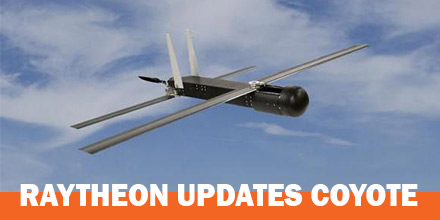Raytheon Announces Block 2 Update for Coyote tube-launched UAS
 Recently, Raytheon announced the development of a “Block 2” update of the Coyote, a tube-launched unmanned aircraft system (UAS) it acquired more than two years ago.
Recently, Raytheon announced the development of a “Block 2” update of the Coyote, a tube-launched unmanned aircraft system (UAS) it acquired more than two years ago.
The aim is to produce a low-cost, multi-mission-capable air vehicle that users ultimately dispose of once it completes a mission.
“We do recover and reuse them in our development work. However, for operational use and purposes, it is meant to be disposable or ‘attritable’. It’s meant to be a one-time platform just like a Tomahawk missile,” said John Hobday, Raytheon’s Coyote business development lead.
“The difference is that we are approaching the Coyote platform not only as a disposable, but as a low-cost system. That’s part of the disruptive nature of what we’re trying to do with this platform—to create this low-cost appliance, if you will.”
History of Coyote UAS
Originally, a company named Advanced Ceramic Research, of Tucson, Arizona, developed the Coyote, Manta and Silver Fox UAS under small business contracts from the U.S. Office of Naval Research (ONR). Defense contractor BAE Systems acquired the company in 2009, then sold it back to one of the former owners under the name Sensintel. Raytheon acquired Sensintel in 2015 and folded the company into its Tucson-based Missile Systems business.
The 13-pound, propeller-driven air vehicle, features foldout tandem wings and tail fins. It deploys from a standard A-size sonobuoy tube with a parachute, or from a pneumatic ground box launcher.
Potential missions include using the Coyote fitted with sensors for intelligence, surveillance and reconnaissance (ISR), as a communications relay, an electronic warfare asset or a loitering munition. Another scenario envisions multiple Coyotes working cooperatively as a drone swarm.
The Coyote is larger and carries a four-pound payload. This is more than available from the similar AeroVironment Switchblade, a six-pound flying munition and ISR platform; and the four-pound Lockheed Martin Vector Hawk, a canister-launched drone that has deployed from an autonomous underwater vehicle.
Coyote UAS Updates
Raytheon (Chalet 294, Static B8) is redesigning the Coyote to incorporate a turbine engine for high-speed applications, in addition to the current battery-powered pusher propeller approach, Hobday said.
The manufacturer’s focus is to maintain a common airframe which can launch from the ground, a ship or an aircraft.
The National Oceanic and Atmospheric Administration (NOAA) used the Coyote as a sensing platform to conduct hurricane research. The agency first deployed the small UAS in a hurricane in September 2014 when it launched the Coyote from a Lockheed WP-3D Orion turboprop into the eye of Hurricane Edouard.
The Lockheed Martin C-130 and Cessna Caravan have also served as launch platforms for the Coyote, Hobday said. Under an ONR future naval capability program, Raytheon is working to introduce it on the Boeing P-8A Poseidon antisubmarine warfare aircraft, a derivative of the 737-800 airliner.
Work also continues with NOAA and the four U.S. military services, Hobday said. He declined to comment on a report in specialist defense journal Janes earlier this year, based on an interview with Raytheon executives, that the U.S. Army has asked the company to develop the Coyote as a counter-UAS asset to intercept rogue drones.
“All of the various iterations of the Coyote airframe are driven by customer requirements,” Hobday said. “This is a system that we can very rapidly modify for emerging missions to meet new requirements that our various Department of Defense customers have for different types of missions, different concepts of operation.” He added: “Always the intent is a very low-cost, commoditized ‘truck’ that is disposable at the end of whatever its defined mission is.”

